“An appreciation of the connection between mathematics and music dates back at least to Pythagoras, but rarely does one have a chance to explore that connection in such intimate detail as in these bracing pages. Composer Tom Johnson weaves back and forth between notes and numbers, delighting in patterns that lead up to self-similarity (the basic of fractal geometry). Some familiarity with both sides of the topic is a prerequisite; committed readers will, however, receive a unique aesthetic education.”
–Scientific American, May 1997
Self-Similar Melodies
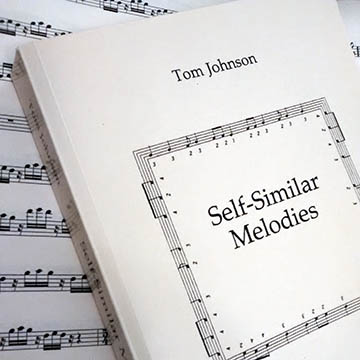

Tom Johnson
Tom Johnson (1939-) studied in Yale and privately with Morton Feldman. A selection of his columns published in The Village Voice is available at The Voice of New Music. The collection of radio programs Music by my Friends offers a personal hearing of composers like Morton Feldman or John Cage. His latest book deals with Other Harmony.
All his works are available at Editions 75 and 218 Press.
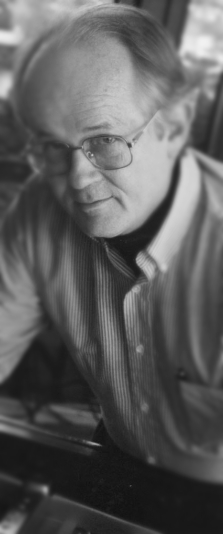
Introduction
Download
I should begin by tracing the main events that led me to Self-Similar Melodies, to give you an idea of where this book is coming from and who is writing it.
My formal education was strictly musical, but I always liked logic and mathematics, and by now I have been thinking about logical progressions in music for almost 30 years.
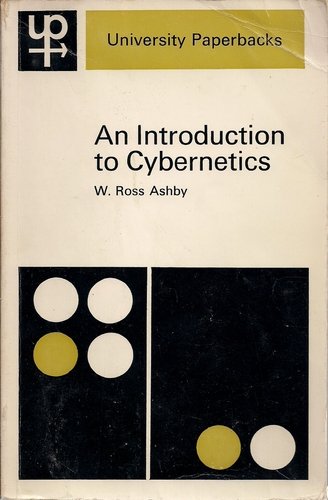
At first my main source of information was W. R. Ashby’s An Introduction to Cybernetics, which I read with great enthusiasm in 1966, as a student, and which provided the basis of a paper I wrote the following year called “Music as Machine.” I wasn’t able to go much further in this direction though, either musically or theoretically, until 1979 when someone gave me Douglas Hofstadter’s Gödel Escher Bach for Christmas.
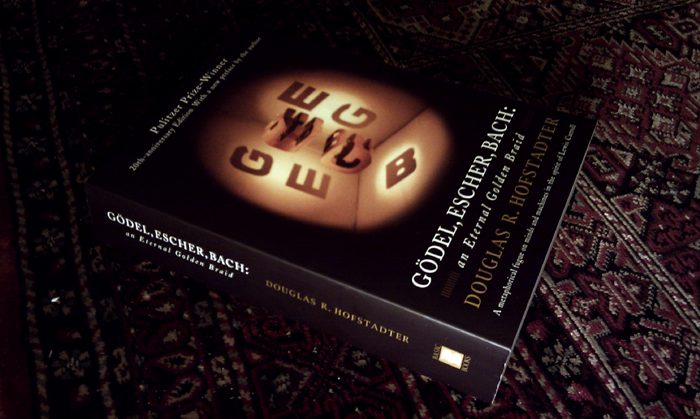
Around that same time I also found Benoit B. Mandelbrot’s Fractals, and Martin Gardner’s Mathematical Games columns in Scientific American, and met David Feldman, a mathematician-composer who helped me understand what I was reading.
With this
information I was able to make some important breakthroughs in my composing, especially
with Nine Bells (1979) and the
Rational
Melodies (completed in 1982), though much of my music, such as Riemannoper, was relatively
uninfluenced by logical sequences. Beginning in 1987, when I wanted to write
mathematical Music for 88, I went
back to mathematics once again. I read Euclid’s number theory, Euler’s Mathematische Musik, and some books on
the history of mathematics, and followed a series of stimulating but difficult
lectures in number theory given by Michel Waldschmidt at the Université de
Paris VI. Then I met the mathematician Jean-Paul Allouche, who helped me a great
deal, and continues to do so, and I read
Chaos and Fractals by Heinz-Otto
Peitgen, Hartmut Jürgens and Dietmar Saupe, 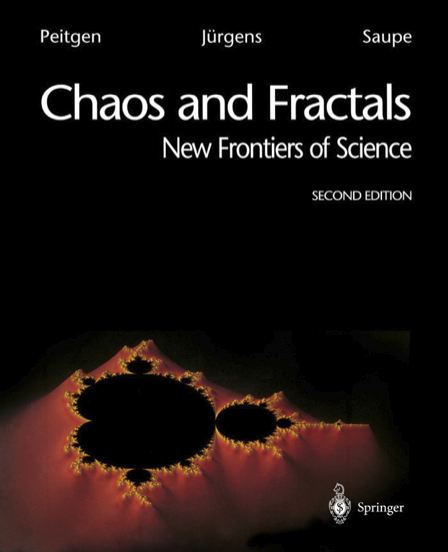 which turned out to be a gold mine
of information about mathematical systems, many of which related to my musical
systems. Also important has been Paul Epstein, a composer and colleague in
Philadelphia. Our correspondence since 1990 has been especially useful
regarding self-replicating melodies.
which turned out to be a gold mine
of information about mathematical systems, many of which related to my musical
systems. Also important has been Paul Epstein, a composer and colleague in
Philadelphia. Our correspondence since 1990 has been especially useful
regarding self-replicating melodies.
During all this time I was gathering notes and charts and computer programs, but I was always busy trying to produce pieces of music, and I never wanted to take the time to try to explain the techniques I was using. Eventually, however, my files of such things were overflowing, and I wasn’t even sure myself anymore what I had been doing and what I should do next. It was time to clean out my files–and my head. As I began to go through piles of forgotten paper, it seemed that it would be good to try to put together a summary of this information. Not only was it necessary to put my own thoughts in order, but much of what I had developed seemed potentially useful for other composers and music theorists, and perhaps also for some non-musicians interested in logical systems. In order to put all these ideas together in a coherent way that you can hopefully understand, I needed to limit my subject, and it seemed to me that the majority of the most interesting ideas I had been exploring could all be defined as “self-similar melodies,” a term which I had best define before I go any further.
To define “self-similar” in all its mathematical senses would require going into Cantor staircases, Sierpinsky sponges, Hilbert curves, Peano curves, and many other subjects. Numerous other books already do all this, and there is no need for a musician like myself, with only a limited understanding of the subject, to attempt to do it again. Besides, melodies are basically one-dimensional, whereas most of these mathematically studied types of self-similar structures are two- and three-dimensional. The principle of a self-similar structure is the same in all cases, however: a structure that replicates itself on more than one level. A self-similar melody, then, is a melody in which the detailed movement from note to note is reflected in the way the melody as a whole is structured, and the larger organization reflects the details. This is not very precise language, so I will also give you an exact definition, which I can adhere to throughout this study:
Most of the sequences of notes and numbers in this book have exactly the same organization embedded on at least two levels in a way that is clear and indisputable, but there are a few cases where one could dispute whether the self-similarity is really exact, so that is why I have made my definition somewhat cautiously. Of course, if a single procedure is repeated many times, there will necessarily be some relationship not only between the second, third, and fourth outcomes of this procedure, but also between the second, fourth and sixth outcomes, and between the third, ninth and 27th outcomes, and so on. So my definition is not far from those of Mandelbrot, Peitgen, and of current mathematicians in general.
Self-similarity may seem like something that has very little to do with music, but in fact it goes to the very center of what composition has been about in the 20th century, and much of the 19th century as well. I once asked John Cage, whom I had the good fortune to know fairly well, what he really learned from his teacher Arnold Schoenberg. Usually Cage responded to this question with the often published anecdote about how Schoenberg said he would never have a sense of harmony. But this time, speaking informally late in his life, he replied differently. “I think the most important thing I learned from him was that the microcosm and the macrocosm should be related. Schoenberg talked often about that, and started me thinking in this direction.”
The relationship is rather easy to see in the music of Cage, where chance determines what happens on every level, from the overall form to the individual note, and it is not difficult to understand how Schoenberg must have thought about the relationship between his angular expressionistic instrumental lines and the angular expressionistic forms that contain them. It should be pointed out too that both Cage and Schoenberg were no doubt familiar with the theoretical studies of Heinrich Schenker, who demonstrated in detail how the individual harmonies and melodic motions reflect the forms and modulation schemes in the great German tradition from Bach to Brahms. Schenker thought that 20th-century music had nothing to do with his studies of musical “foreground,” “middleground,” and “background,” and it is true that such relationships are difficult to find in Stravinsky, Bartok, Berio, and in fact, the majority of 20th-century music. But foreground-background relationships are very clear in the music of Schoenberg and Cage, though they did it in ways quite different from one another, and from Beethoven. The more precisely calculated microcosm-macrocosm relationships that you shall find in the melodies of this book are simply other manifestations of the same principle.
Limiting my subject in this way has of course required eliminating many things. Combinations and permutations, for example, have been especially useful to me as a compositional tool. How many melodies can be constructed by passing through a single grid or labyrinth? How many melodies of eight notes can one construct using only thirds and fourths? Such questions have sometimes been very useful in composing, but they are not really relevant to self-similar structure. I also had to forget techniques having to do with special musical materials such as glissandos, and eliminate everything having to do with counterpoint, orchestration and other non-melodic aspects of music.
In addition, I decided to exclude analysis of my own compositions. Actual compositions are full of texts and contexts, instrumentation and interpretation questions, humorous notes and satiric notes, ethical and political messages, and all sorts of things that are difficult to explain and have little or nothing to do with the behavior of self-similar melodies. So the examples in this book were all written specifically to demonstrate whatever they demonstrate and are not intended to have any particular musical value outside this context. At the end of each section, references are given to actual compositions using the techniques discussed, for those of you who get tired of looking at the short examples and want to see what these things might sound like in real pieces of music.
To abstract the musical examples, and to make them relevant in a more general sort of way, I have written most of them with percussion clef, simply indicating higher and lower scale degrees. This gets us around the problem of whether the particular example might sound better in the upper register or the lower register, in one mode or another, on a European scale or in some other tuning system, and other such considerations having nothing to do with self-similar melodic structure. And very often, when I just wanted to show a short sequence of notes growing into a longer melody, I haven’t used musical symbols at all, but simply numbers.
One more thing before we get started. This book is not about esthetics. I am going to simply assume that you are sympathetic with what I would call a rationalist or structuralist approach to art and music, and I won’t attempt to convince you that this approach is necessarily better than any of the romantic, expressionistic, intuitive, mystical and otherwise subjective approaches to art and music. But a brief summary of the structuralist point of view should help you to orient yourself to the topography of this book, and see how you want to move around in it.
The structuralist supposes that conscious awareness is more interesting than dreams, that it is better to know what one is doing than not to know, and that objective reality is more interesting than subjective experience. The structuralist prefers to think about up and down, single and double, greater and smaller, things that are not limited to particular cultures and particular periods of history. The structuralist tries to work with elements that can be defined and measured, and tries, as much as possible, not to think about things that can not be defined and measured, such as fear, beauty, perception, boredom, and inspiration.
But having written that paragraph, I must quickly point out that many questions remain: Why is it, even after something has been rigorously proved, that it can sometimes continue to seem ultimately mysterious? What are my motivations for doing what I do? Why do I find that one descending melody thrills me while another descending melody, written with exactly the same self-similar procedure, leaves me completely cold? Why is it that I have so much trouble going to sleep when I know there is an uncorrected error in some score I am working on? Are we talking about detached logic or total compulsiveness?
You’ve probably heard many times terms like “cold facts” and “hard logic,” but rationality is neither hard nor cold when it is done by soft warm-blooded animals like ourselves.
Introduction::References
Self-Similar Melodies::Introduction::References
Allouche, Jean-Paul and Johnson, Tom: “Finite Automata and Morphisms in Assisted Musical Composition” (1994), published by the Laboratoire de mathématiques discrètes, Centre national de la recherche scientifique, Marseille. This short collaborative study is primarily a mathematical analysis of the formulas used in my Formulas for String Quartet (1994), but it also provides an introduction to automata in general, and to how they can be applied to music.
Ashby, W. R.: An Introduction to Cybernetics, (1963), Wiley, New York. When computer science was still young and the principles of artificial intelligence were still new, the discussion was on a rather theoretical level, and I came away with a new understand of things like “switches” and “transformations.” I suspect the book is still stimulating for many readers today.
Hofstadter, Douglas: Gödel Escher Bach (1979), Basic Books. This layman’s guide to Gödel also taught me a lot about logical sequences, recursive functions, and many other things. It was a very popular book in America at this time.
Gardner, Martin: The “Mathematical Games” columns, which Gardner wrote for many years in Scientific American, contain hundreds of ideas that can be useful for musicians and artists, but the most important for me personally were the explanations of the “Dragon” formula in several installments in 1967.
Johnson, Tom: I’ll give references later to specific compositions having to do with
specific phenomena, but three scores should be cited already, since they are
particularly important in the general evolution of my “self-similar
melodies.”
Nine Bells (1979), Editions 75, is a 50-minute dance/performance played on nine
suspended bells. It is one of my first pieces that really follows logical
sequences, though the logic is more geometric than numeric.
Rational Melodies (completed in
1982), Editions 75, is a collection of 21 melodies for any instrument, with
explanations of the processes used to compose them. Also available as a CD (Hat
Art 613).
Music for 88 (1988), Editions 75.
Nine separate pieces including the Mersenne
Numbers, the Multiplication Table, Abundant numbers, Square Numbers,
Eratosthenes’ Sieve, Euler’s Harmonies, and Pascal’s Triangle. Also
available as a CD (Experimental Intermedia XI 106).
Mandelbrot, Benoit B.: Fractals: Form, Chance and Dimension (1977), W. H. Freeman and Co. A lot of the mathematics went over my head when I first read this book, and some of it still does, but I could look at the pictures and see what Mandelbrot was talking about, and I learned a lot about self-similar structure.
Peitgen, Heinz-Otto, Jürgens, Hartmut and Saupe, Dietmar: Chaos and Fractals (1st edition 1992, 2nd edition 2004), Kaiser Verlag. A big book, over 900 pages long, that assembles mountains of recently discovered information in a way that non-mathematicians can understand. The second chapter (pp. 63-134) provides a very good overview of “Classical Fractals and Self-Similarity.” Later I’ll be making use of specific ideas from this book, such as the MRCM (multiple reduction copying machine), and repeating some of the observations on Pascal’s triangle and other automata. These mathematicians, and their colleagues at the Centrum für Complexe Systeme und Visualisierung in Bremen, have produced a number of books, often with very attractive computer graphics, but this is the one I read, and perhaps the most complete at this point.
Counting
Self-Similar Melodies::Counting chapters
Counting 123
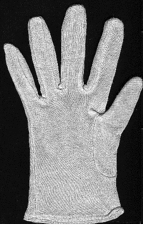
Let’s start with what must be the most basic possible logical process: counting. These days our pocket calculators do most of our counting for us, but we continue to do a lot of it ourselves. Soldiers often count the cadence as they march, partly to relieve fatigue, and partly from the simple pleasure it brings. Agricultural surveyers sometimes count the blades of grass in a sample area. Individuals practicing meditation may count breaths, beads, or prostrations. Musicians and dancers count all the time, in every culture and period, at least if they want to end together. Many of us count the steps as we ascend long staircases, though we often don’t like to admit it. The farmer counts his sheep, the astronomer counts galaxies, the laboratory technician counts red blood cells, we all count money, and the census counts us. Even the mother cat with five kittens seems to be able to count. At least she somehow detects a difference when she can only find four of them. What are we all really doing when we count? (…)
Counting Several Things at Once
Counting in Other Bases
Counting in Circles
Counting with Computer
Counting::References
Self-Similar Melodies::Counting::References
Johnson, Tom: Counting Keys (piano, 15 minutes), Counting Languages (voice, 22 minutes), Counting Duets (two voices, 10 minutes) are specific pieces, sometimes programmed under the generic title of Counting Music. All were composed around 1980-82. Trinity (1978) is a choral piece that literally counts 1 2 3 on the same three notes for three movements. There are four antiphonal choirs and quite a few rhythmic variations. The Rational Melodies (1982) often follow counting structures. No. I moves isometrically around a rhythmic circle of 25 notes and a melodic circle of 6 notes. No. XVII follows this process with a color of 16 notes and a talea of 13 notes. No. XXI moves systematically around a circle that keeps shrinking. No. VI is a kind of 1 1 2 1 1 2 3 2 1 counting. No. VIII counts 1 2 3 4 on four levels. No. X counts three digit numbers in base four. No. III and No. IV count in circles in other ways, No. XVII and No. XVIII are basically “filling in,” No. XIII could be called reverse accumulative repetitive counting, and No. IX follows a count-ing procedure that does not seem to be described here any-where. “Multiplication Table” in the Music for 88 (1988) counts on two levels, like all multiplication tables. Six Note Melody (1986) is an organ piece that counts to six on two hands and two feet, thus arriving finally at 64.. Formulas for String Quartet (1994) contains one movement, the sixth, in which the four instrumentalists are all counting around circles of different sizes in different tempos.
Morrow, Charlie: The Number Six (1978). This is a two-hour work in which the composer simply speaks the words “one two three four five six” into six different microphones, following logical sequences. Charlie is an old friend, and I have appreciated many of his pieces, but this one knocked me out and no doubt influenced the evolution of my own music. Charlie also did a lot of shorter “counts” around this time, sometimes with visual elements, sometimes with audience participation, often with a sense of humor. He pretty much discontinued this aspect of his work in the early 80s, however, to concentrate on outdoor events and installations, as well as film scores and commercial projects. I revived The Number Six myself by counting it out at the Podewil Theater in Berlin in 1994, and the piece remains very strong, though pretty extreme. Two hours is a long time to listen to numbers, and the piece will never be programmed very often, but it will certainly be remembered for a long time by some of us who have heard it.
Transforming
Self-Similar Melodies::Transforming chapters
Transforming Ones and Zeros
Transforming Dragons
In the mid-60s a NASA physicist, John E. Heighway, began to study what happened if he folded a piece of paper in half, over and over, always in the same direction. What would be the sequence of left and right folds when he opened up the paper and looked at it? Well, what happened was that no matter how many times he folded the paper, and no matter how long the sequence of left and right turns became, the result when he drew the left and right turns on graph paper always had a sort of head, two feet, and a long curling tail. So Heighway baptized this peculiar beast the "dragon curve." In the ensuing years, the sequence has become one of the best known and most often studied binary automata. So there is much to say on this subject, and that's why I'm giving you a special chapter on dragons, separating them from other binary beasts. (…)
Transforming by Finite Automaton
Transforming by Infinite Automaton
Transforming Sandwiches
Transforming by Erasing
Transforming with Delays
Transforming Hybrids
Transforming in Parts
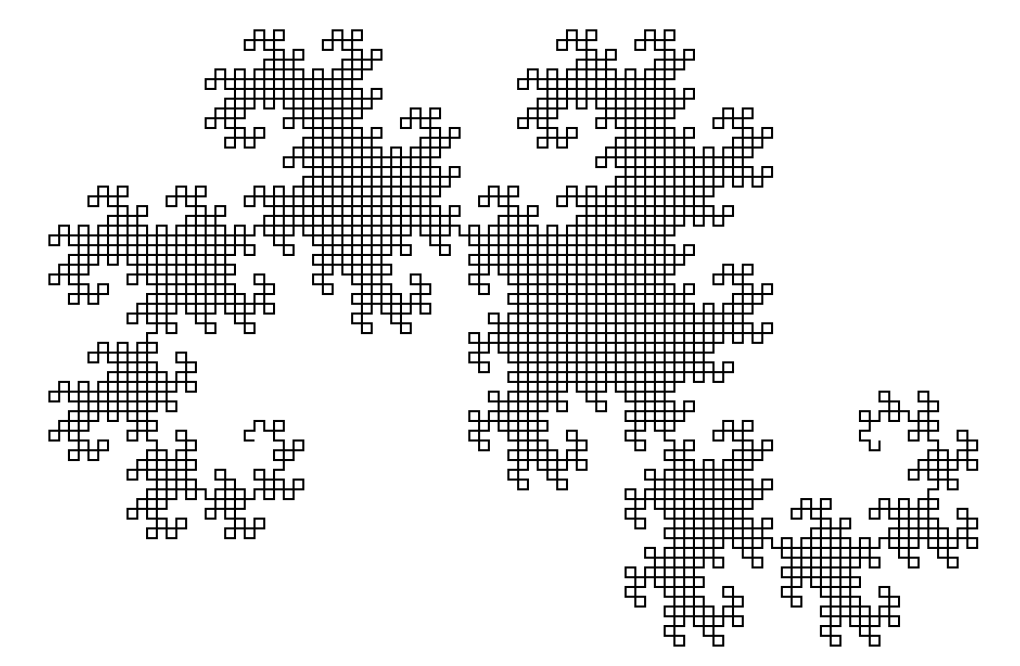
Transforming::References
Allouche, Jean-Paul: “Automates finies en théorie des nombres” in Expositiones Mathematicae 5 (1987), pp. 239 - 266. A rather technical and thorough explanation of the Thue-Morse sequence, the Rudin-Shapiro sequence, the Baum-Sweet sequence, and the paper-folding sequence, along with many of the author’s own ideas.
Dekking, Michel, Mendès France, Michel, Van der Poorten, Alf: “Folds” (1982), in the review Mathematical Intelligence. A mathematician’s guide to paper folding, exploring a complexity that I’ve only hinted at here.
Gardner, Martin: “The Fantastic Combinations of John Conway’s New Solitaire Game ‘Life’,” in the “Mathematical Games” column, Scientific American, April 1970. A good explanation of one of the best known and most interesting automata. See also the column of February 1971.
Johnson, Tom: Automata of various kinds can be found in the fourth movement of Movements (1980), Doublings for Double Bass (1980), and the Infinite Melodies (1986). The Dragon formula is used for the “Mersenne Numbers” in Music for 88, (1988), as well as in Dragons in A (1980). Rational Melody No. II is a dragon formula that folds the paper in thirds, and No. XIX follows the reverse paper-folding formula, as does the seventh movement of Formulas for String Quartet (1994). Sandwich procedures can be found in the first and last movements of Formulas for String Quartet, as well as in the second and third movements of Movements (1980). Rational Melodies XIV, XX, and XVI are all sandwiches, though in the last case the music is unmaking the sandwich instead of making it. The second movement of Formulas for String Quartet is a kind of hybrid, while the fourth movement of that piece is a case of transforming in parts.
Narayana (14th century) was an Indian mathematician, whom I read about in a history of mathematics, and who proposed the following problem: “A cow produces one calf every year. Beginning in its fourth year, each calf produces one calf at the beginning of each year. How many cows and calves are there altogether after 20 years?” This became the narration accompanying Narayana’s Cows (1989), which follows this formula. Later, while writing this book, I asked myself what would happen if the cows began giving birth immediately, or after one year, or two years, or six years, and wrote the analysis that became the chapter on “Transforming with Delays.” Jean-Paul Allouche and I presented a more precise study entitled “Narayana’s Cows and Delayed Morphisms” at the 1996 JIM (Journées de l’informatique musical), published in the Cahier du GREYC 96-4, Université de Caen.
Toffoli, Tommaso, and Margolus, Norman: Cellular Automata Machines, (1987), MIT Press. This very readable book treats all sorts of two-dimensional automata, random inputs, biological parallels, block rules, and hydrodynamic applications, and includes programs for realizing everything on your computer screen.
Ulam, Stanislaw: “Random Processes and Transformations” in Procedures of the International Congress of Mathematicians (1950), pp. 264 - 275. The first mathematical research in the direction of automata.
Von Neumann, John: Theory of Self-Reproducing Automata, edited and completed by Arthur Burks (1962), University of Illinois Press. One of the earliest attempts to see cell-reproduction in a mathematical way.
Wilson, Wilfred G.: Change Ringing (1965), London. Wilson also wrote the five-page entry on “Change Ringing” in the New Grove Dictionary of Music and Musicians (1980), which will tell you quickly about forward hunting, backward hunting, Plain Bob Minimus, Grandsire Doubles, and how to call bobs and singles. Other written sources on the subject go back as far as the 17th century.
Mapping
Self-Similar Melodies::Mapping chapters
Mapping the Towers of Brahma
There is not a great difference between the idea of "mapping" and the idea of "transforming," and in fact, many logical sequences can be explained in both ways, and sometimes in some additional ways. The problem is that I am talking about a very large network of highly related procedures, and I need to organize the discussion in some way. Separating transforming from mapping is one way of doing this, and it really is a useful distinction.
In the last section we were transforming sequences into other sequences, usually longer ones. The point of departure was always just numbers or notes, and the mecanisms were abstract formulas, automata, "goes to" statements. There were no sources outside music and mathematics. Now, however, we will be working with analogies, taking structures that already exist in some other domain, such as a game or a two-dimensional model, and translating them into melodies. The word "translating" is perhaps as appropriate as "mapping," and I might also say that I am going to be "coding" or "decoding" things, but "mapping" is a term often used in mathematics, and it is not difficult to hear music as a map that charts some more concrete phenomenon. If one takes the ups and downs of the New York skyline, or the structure of a DNA molecule, or a chart of all the stars in the Australian sky, and turns them literally and directly into pieces of music, it is like making musical maps of these regions. This is quite possible, and in fact, these three things have already been done by other composers.(…)

Mapping Pascal's Triangle
Mapping Fibonacci
Mapping Geometric Patterns
Mapping Weaving Patterns
Mapping with Computer
Mapping::References
Grünbaum, Branko and Shepherd, Geoffrey: “Satins and Twills: an introduction to the geometry of fabrics” Mathematics Magazine Vol. 53 No. 3, May 1980. It was David Feldman who suggested I read this article, and it was a good idea. Much of the mathematics went over my head, but the principles were easy to perceive in the many illustrations, and it taught me to look for such things.
Hofstadter, Douglas: The column “Thèmes mathématiques” in the September 1983 issue of Pour la Science discusses “les tours de Brahma.” See also No. 69 of the same publication. These columns, and their English equivalents in Scientific American, have continued the tradition established by Martin Gardner, and have provided an ongoing stream of mathematical information for the general reader. Fractals and automata have been common topics.
Johnson, Tom: Le Triangle de Pascal modulo sept (1995), a radio program produced by René Farabet for the Atelier de création radiophonique, France Culture, includes nearly two hours of music, in which a computer-controlled synthesizer plays Pascal’s triangle down to line 343 on a seven-note scale. One also hears commentary by Johnson and Jean-Paul Allouche, some written dialogue, and quotations from Pascal’s writings. There is a piano piece called “Pascal’s Triangle” in the Music for 88 as well, but this is a collection of all the chords possible with two intervals, and thus a matter of combinations rather than self-similar sequences. Voicings for four pianos (1986), the last movement of Le Choeur (1993), Composition with Ascending... (1992) and Composition with Descending... (1992) are the best examples of weaving patterns in my music, though there are some short ones, with their visual parallels, in the Symmetries for piano four hands (1981-1992). Nine Bells (1979) and Symmetries are both largely the result of mapping geometric patterns. In the first case the music comes from paths around a grid three by three, while the Symmetries are precise mappings of geometric drawings, which are included in the score. Movements (1980) employs embedded Fibonacci numbers quite literally in its first movement, but more subtle examples of embedded Fibonacci numbers can be found in the second and fourth movements of the Formulas for String Quartet (1994).
Pascal, Blaise: Traité du triangle arithmétique, in the Oeuvres complètes, pp. 97-171, Gallimard, 1980.
Peitgen, Heinz-Otto, Jürgens, Hartmut and Saupe, Dietmar: Chaos and Fractals, (1992), Kaiser Verlag. The chapter on “Pascal’s Triangle,” pages 407 - 456, is especially rich. The authors design a two-level automaton that generates the complex patterns of Pascal’s triangle modulo 4, for example, which is much harder to do than you might think. They also discuss Pascal’s triangle as a cellular automaton, as an IFS (iterated function system), as an HIFS (hierarchical IFS), as a networked MRCM (multiple reduction copying machine), and as a fractal with a Hausdorf dimension - all useful concepts. My chapter on “Mapping with Computer” depends particularly on this book, as does my presentation of the Hilbert curve.
Self-Replicating
Self-Similar Melodies::Self-replicating chapters
Self-Replicating Melodies
You’ve probably all been wondering what that melody going around and around the rectangle on the cover is all about. The adage that you can’t tell a book by its cover is generally true, but in cases like this, where the same person who writes the book also designs it, the cover is not just a cover, and in fact, this cover contains a melody that pretty much covers everything covered in this book.
I’m sorry to have made you wait 233 pages before telling you what this endless rectangular melody is all about, but it seemed necessary to explain a lot of other things first. It is highly relevant to this last section of the book, however, in which I will try to tell you everything I know about melodies of this sort. That’s not as much as I’d like to be able to tell you, but it will be enough to fill about 40 pages, and hopefully enough to provide a basis for more complete analysis later. The ideas in this section are the most original, and potentially the most useful of the book, but there are a lot of them, and they are interrelated in complicated ways that no one has really studied yet. So what I’m giving you here should be regarded as an introduction to self-replicating melodies, and not a general theory of self-replicating melodies. Let’s go back to the cover.
What we have on the cover is a 43-note melodic loop with no beginning, no end, and several peculiar characteristics:
- If you begin with the low note in the top line, you have the same sequence of notes whether you read consecutive notes, every second note, every fourth note, or count by some other power of two, and you can continue going around the rectangle as many times as you wish, counting in any of these ways.
- The melody is a palindrome, so it won’t matter if you read clockwise or counter-clockwise.
- It moves up and down on a four-note scale, but one of these four notes, the low-note starting point, is used only once, while the rest of the melody is equally distributed between the other three.
- The rhythmic values are completely redundant, since notes 1 and 3 are always quarter notes while 2 and 4 are always eighth notes. In fact, the rhythmic values are there only to make the sequence of notes more attractive to see and hear.
(...)
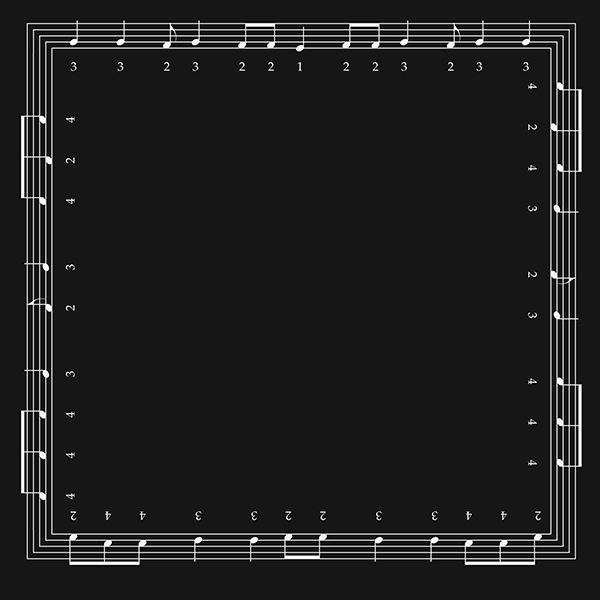
Self-Replicating Several Ratios
Self-Replicating Related Melodies
Self-Replicating with Holes
Self-Replicating::References
Epstein, Paul: “Self-Replicating Melodic Patterns” (1992), lecture read at the National Conference, Society of Composers, University of Alabama, in Tuscaloosa Alabama. Epstein explained the technique used in the first self-replicating melody, Rational Melody No. 15, and discussed how he had used the same principle in his Bird Songs, and Variations for String Orchestra. This is the first use of the term “self-replicating,” a term that seems much clearer than “layered” melodies, as I called them in the notes to the Rational Melodies 10 years earlier. Epstein, who is a professor of theory at Temple University, in Philadelphia, has continued to use self-replicating loops, such as the 56-note one from his Solstice Canons (1993), explained at the end of the chapter on self-replicating related melodies.
Johnson, Tom: Rational Melody No. 15 (1982) uses a 15-note loop that self-replicates at 2:1. It has the form 1 2 2 3 2 4 3 5 2 3 4 5 3 5 5 and progresses by “filling in” the 2:1 copy while playing the 1:1 original. I thought at the time that this was just a curiosity and had no idea I was opening up a vast area that I would still be trying to understand 14 years later.
Collaboration I was music for piano four-hands, which I used to play with my collaborator, Philip Corner, around that same time. We never made a score of this piece, because it was mostly improvised, but we followed strict rules. One hand started a melodic loop of three, four, or five notes, and the other three hands added loops with the same notes in different tempos, but always in unison. We made a lot of mistakes, but we learned a lot about what I refer to here as “related melodies."
Mélodie de six notes [Six Note Melody] (1987), Editions 75, is an organ piece with a simple chromatic loop of six notes, played in two hands and two feet in the ratios 1:1, 7:1, 49:1 and 343:1, which keeps them always in unison.
Einstimmiger Polyrhythmus (1992) is my first long composition exploiting self-replicating melodic loops. The seven-note loop 1 2 2 3 2 3 3 and its relative 1 3 3 2 3 2 2 are particularly evident. Another section involves punching holes in a four-note loop, or running this four-note loop through longer taleas, if you prefer. The last section works
with all the related melodies derived from a 1 2 3 4 5 1... loop. The piece was commissioned by the Hannover Gesellschaft für Neue Musik and was premiered in Hannover in 1992 by the saxophone-guitar-bass trio Ugly Culture, which was founded by bassist Martin Ingenhütt and is based in Cologne. Einstimmiger Polyrhythmus means “unison polyrhythms,” which seems to me to be a very good term for defining all these techniques in a more general way.
Publisher/How to order
Self-Similar Melodies::Publisher
Self-Similar Melodies is published by Editions 75 and co-published by 218 Press
To order contact:
info (at) editions75 [dot] com
orders (at) editions75 [dot] com
Or from the Americas:
presstwoeighteen (at) aol [dot] com
Self-Similar Melodies: 24 euros/30 dollars
